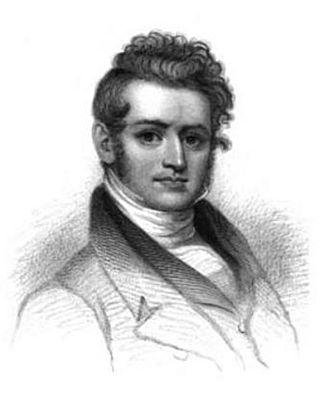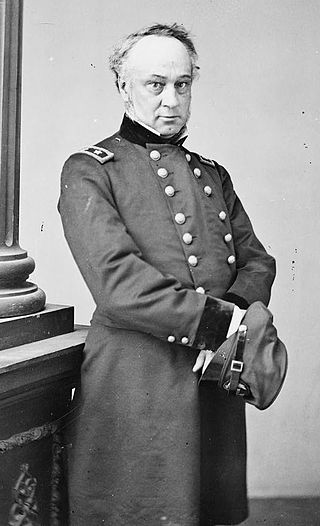
Monongalia County, known locally as Mon County, is located in the U.S. state of West Virginia. As of the 2020 census, the population was 105,822, making it West Virginia's third-most populous county. Its county seat is at Morgantown. The county was founded in 1776. Monongalia County is included in the Morgantown, WV Metropolitan Statistical Area, and is the largest county in North-Central West Virginia. It is part of the Pittsburgh media market.

George Gordon Meade was a United States Army Major General who commanded the Army of the Potomac during the American Civil War from 1863 to 1865. He fought in many of the key battles of the Eastern theater and defeated the Confederate Army of Northern Virginia led by General Robert E. Lee at the Battle of Gettysburg.

Joseph Rodman Drake was an early American poet.

Henry Wager Halleck was a senior United States Army officer, scholar, and lawyer. A noted expert in military studies, he was known by a nickname that became derogatory: "Old Brains". He was an important participant in the admission of California as a state and became a successful lawyer and land developer. Halleck served as the General-in-Chief of the Armies of the United States from 1862 to 1864, and then became Chief of Staff for the remainder of the war when Ulysses S. Grant was appointed to that position.

Don Carlos Buell was a United States Army officer who fought in the Seminole War, the Mexican–American War, and the American Civil War. Buell led Union armies in two great Civil War battles—Shiloh and Perryville. The nation was angry at his failure to defeat the outnumbered Confederates after Perryville, or to secure East Tennessee. Historians generally concur that he was a brave and industrious master of logistics, but was too cautious and too rigid to meet the great challenges he faced in 1862. Buell was relieved of field command in late 1862 and made no more significant military contributions.

The Army of the Tennessee was a Union army in the Western Theater of the American Civil War, named for the Tennessee River.

Fitz-Greene Halleck was an American poet and member of the Knickerbocker Group. Born and raised in Guilford, Connecticut, he went to New York City at the age of 20, and lived and worked there for nearly four decades. He was sometimes called "the American Byron". His poetry was popular and widely read but later fell out of favor. It has been studied since the late twentieth century for its homosexual themes and insights into nineteenth-century society.

Charles Abraham Halleck was an American politician. He was the Republican leader of the United States House of Representatives from the second district of Indiana.

George Washington Cullum was an American soldier, engineer and writer. He worked as the supervising engineer on the building and repair of many fortifications across the country. Cullum served as a general in the Union Army during the American Civil War, primarily in the Western Theater and served as the 16th Superintendent of the United States Military Academy. Following his retirement from the Army, he became a prominent figure in New York society, serving in many societies, and as vice president of the American Geographical Society. The society named the Cullum Geographical Medal after him.

Nicasio Creek is an 11.9-mile-long (19.2 km) stream in Marin County, California, United States and is the primary tributary of Lagunitas Creek, which flows, in turn, into Tomales Bay, and the Pacific Ocean. The Nicasio Reservoir, formed in 1961 by Seeger Dam, is located on this stream.

Halleck is an unincorporated community in central Elko County, northeastern Nevada, in the Western United States.

Quick is a small unincorporated community in Kanawha County, West Virginia, United States. It is located along Indian Creek Road. The community is where Whitoak Fork and Blue Creek come together and meet. It is also where the abandoned railroad that follows Blue Creek joins the road, and follows it all the way to the community of Hitop, along Pond Fork. Its post office is closed.
Belva is an unincorporated community and census-designated place in west Nicholas County and north Fayette County, West Virginia, United States; while the CDP only includes the Nicholas County portion, the Fayette County portion is considered part of the community. The town is situated at the bottomland surrounding the convergence of Bells Creek with Twentymile Creek and, subsequently, Twenty Mile Creek with the Gauley River. Belva is also the location of the convergence of two state highways: West Virginia Route 16 and West Virginia Route 39.
Halleck, Peachy & Billings was one of the leading early law firms in San Francisco, California and specialized in land cases. The firm was organized by Frederick H. Billings and Archibald Carey Peachy in 1849, who were joined soon after by Henry Wager Halleck. Halleck, Peachy & Billings was employed by claimants in the settlement of titles to Mexican land grants. The firm dissolved in 1861 after Halleck returned to military life and left California.

Fort Halleck was a military outpost that existed in the 1860s along the Overland Trail and stage route in what was then the Territory of Idaho, now the U.S. state of Wyoming. The fort was established in 1862 to protect emigrant travelers and stages transporting mail between Kansas and Salt Lake City, Utah, and named for Major General Henry Wager Halleck, commander of the Department of the Missouri and later General-in-chief of the Union armies.
Coco is an unincorporated community in Kanawha County, West Virginia, United States.

Pequop or Pequop Siding is a ghost town in Elko County, Nevada, United States. It was located west of Toano on the route around the north end of the Pequop Mountains between Cobre and Wells. It was first a stop station of the Central Pacific Railroad and later a non-agency station on the Southern Pacific Railroad. Several buildings were erected to house section crews.
Halleck is an unincorporated community in Buchanan County, in the U.S. state of Missouri.
Manhattan Community Access Corp. v. Halleck, No. 17-1702, 587 U.S. ___ (2019), was a United States Supreme Court case related to limitations on First Amendment-based free speech placed by private operators. The Court held that a public access station was not considered a state actor for purposes of evaluating free speech issues in a 5–4 ruling split along ideological lines. Prior to the Court's decision, analysts believed that the case had the potential to determine whether limitations on free speech on social media violate First Amendment rights. However, the Court's narrow holding avoided that issue.
















